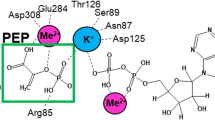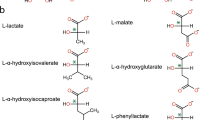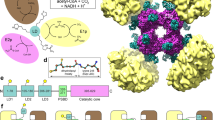Abstract
STUDIES1,2 of the amino acid sequence and crystal structure of M4 lactate dehydrogenase (EC 1.1.1.27) indicate that all binding interactions are of the weak, non-covalent type (proceeding with only minor free energy changes). Because critical regions of the substrate and coenzyme-binding site seem highly conserved3, and because non-covalent interactions are highly, if differentially, sensitive to the physical environment4, we wondered how organisms living in widely different temperatures and pressures stabilise enzyme–ligand interactions. We have therefore compared pyruvate binding site functions of lactate dehydrogenases obtained from organisms living in different temperatures and pressures. We used a placental mammal, the ox, with a cell temperature of 37 °C; a marsupial, the possum (Trichosurus vulpecula), with an average cell temperature of 36 °C (ref. 5), two monotremes, the platypus (Ornithorhynchus anatinus), with a cell temperature of about 31 °C (ref. 6), and the echidna (Tachyglossus aculeatus), with a body temperature of 23–32 °C (ref. 7); the goanna (Varanus gouldi), an Australian lizard with a cell temperature ranging from about 20 up to nearly 40 °C (ref. 8); the Pacific coast dogfish (Squalus acanthias), with an average body temperature of about 15 °C; an intertidal sculpin (Oligocottus maculosus), living in varying temperatures between about 5 and 15 °C, and an abyssal teleost fish, Antimora rostrata, with a highly constant body temperature of 2–3 °C. All these, except the dogfish and Antimora, can be viewed as species adapted to 1 atm; by contrast the abyssal species must be able to tolerate pressures of up to several hundred atmospheres, while the dogfish may encounter pressures from 1 to about 100 atm (N. J. Wilimovsky, personal communication). We found that adjustments in enthalpic and entropic contributions to lactate dehydrogenase binding allowed each homologue to bind ligand with similar avidity at its respective “normal” temperature and pressure.
This is a preview of subscription content, access via your institution
Access options
Subscribe to this journal
Receive 51 print issues and online access
$199.00 per year
only $3.90 per issue
Buy this article
- Purchase on Springer Link
- Instant access to full article PDF
Prices may be subject to local taxes which are calculated during checkout
Similar content being viewed by others
References
Holbrook, J. J., Liljas, A., Steindel, S. J., and Rossmann, M. G., The Enzymes 11 (edit. by Boyer, P. D.), 191–268 (Academic, New York, 1976).
Everse, J., and Kaplan, N. O., Adv. Enzymol., 37, 61–133 (1973).
Taylor, S. S., and Oxley, S. S., Fedn Proc., 34, 2335 (1975).
Suzuki, K., and Taniguchi, Y., Soc. exp. Biol. Symp., 26, 103–124 (1972).
Dawson, T. G., and Hulbert, A. J., Am. J. Physiol., 218, 1233–1238 (1970).
Smyth, D. M., Comp. Biochem. Physiol., 45 A, 705–715 (1973).
Schmidt-Nielsen, K., Dawson, T. G., and Crawford, E. C., Jr, J. cell. comp. Physiol., 67, 63–72 (1966).
Bartholomew, G. A., and Tucker, V. A., Physiol. Zool., 37, 341–345 (1964).
Baldwin, J., Storey, K. B., and Hochachka, P. W., Comp. Biochem. Physiol., 52 F, 19–23 (1975).
O'Carra, P., and Barry, S., FEBS Lett., 21, 281–285 (1972).
Mustafa, T., Moon, T. W., and Hochachka, P. W., Am. Zool., 11, 451–466 (1971).
Hochachka, P. W., and Somero, G. N., Strategies of Biochemical Adaptation, 233 (Saunders, Philadelphia, 1973).
Atkinson, D. E., Br. biochem. Soc. Symp. (in the press).
Subramanian, S., Stickel, D. C., and Fisher, H. F., J. biol. Chem., 250, 5885–5889 (1975).
Low, P. S., and Somero, G. N., Comp. Biochem. Physiol., 49 F 307–312 (1974).
Borgmann, U., Laidler, K. J., and Moon, T. W., Can. J. Biochem., 53, 1196–1206 (1976).
Lumry, R., and Rajender, S., Biopolymers, 9, 1125–1227 (1970).
Cohen, S. G., Vaidy, V. M., and Schultz, R. M., Proc. natn. Acad. Sci. U.S.A., 66, 249–256 (1970).
Hochachka, P. W., Comp. Biochem. Physiol., 52 B, 25–31 (1975).
Low, P. S., and Somero, G. N., Proc. natn. Acad. Sci. U.S.A., 72, 3305–3309 (1975).
Author information
Authors and Affiliations
Rights and permissions
About this article
Cite this article
HOCHACHKA, P., NORBERG, C., BALDWIN, J. et al. Enthalpy–entropy compensation of oxamate binding by homologous lactate dehydrogenases. Nature 260, 648–650 (1976). https://doi.org/10.1038/260648a0
Received:
Accepted:
Issue Date:
DOI: https://doi.org/10.1038/260648a0
This article is cited by
-
Urea-requiring lactate dehydrogenases of marine elasmobranch fishes
Journal of Comparative Physiology B (1978)
Comments
By submitting a comment you agree to abide by our Terms and Community Guidelines. If you find something abusive or that does not comply with our terms or guidelines please flag it as inappropriate.



